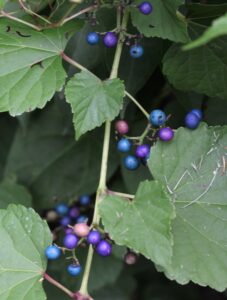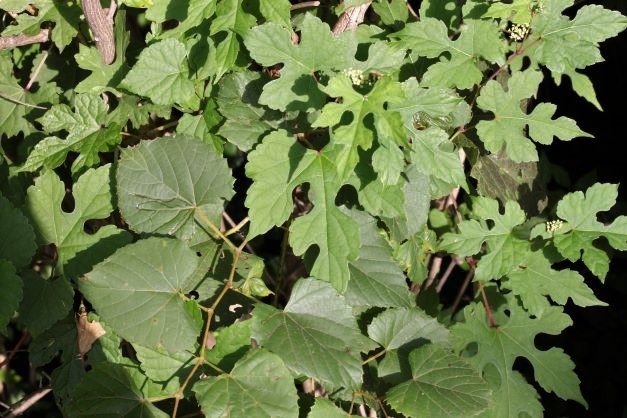An Invasive Coming toward a Greenspace near you

The title of this essay may be misleading. Porcelainberry is not an invasive far away on the horizon – it may already be established in your local park, and it is possibly growing in your garden as well. Perhaps you are mistaking it for a grapevine, a resemblance that could explain why it has spread under the radar, without causing much concern. However, when its berries ripen, which happens from August to October, all illusion lifts and the plant shows its true colors, literally speaking. To our naturalist’s eye, those colors may seem too pretty to be true, indicating that the plant does not belong here. But they also explain why previous generations of gardeners and horticultural entrepreneurs were seduced by the vine and began introducing it from east Asia in the 1870s. Those changing hues are stunning indeed: green, white, pink, lavender, purple and, yes, porcelain blue, all on display simultaneously as the berries mature. What’s not to like about something so pretty? Well, for starters, porcelainberry has escaped cultivation and established itself in natural areas, because its seeds readily germinate even in competitive situations. It is a perennial woody vine that grows fast, up to 15 feet per season. Its stems branch freely so that it can cover large areas of ground and suppress other vegetation. When it finds a tree or large shrub it attaches itself to their smaller branches with tendrils and its weight can cause ice and wind damage to a tree as it flops around at great height. It has been known to kill trees. It grows in sunny or partially shaded locations and thrives in moist areas along creeks, ponds and lakes. Therefore it is particularly prone to invade the vegetative buffers and no-mow strips that nowadays often replace mowed turf grass along the edges of streams. Of course, we must protect urban streams from erosion by sustaining plant buffers that keep their banks in place. But since little regular maintenance tends to occur along a stream once it has received its no-mow designation, these buffers become a breeding ground for all sorts of invasive plants. Poison hemlock has spread in such habitats seemingly unchecked and is very visible in early June when it flowers. Porcelainberry is begging to be noticed right now, in September, as its seeds ripen.

So what to do? First of all, learn to recognize it and to distinguish it from our native grape vine. While both have leaves that are heart-shaped at the base, porcelainberry leaves are often, but not always, deeply dissected. Its stems remain light colored and smooth as they thicken, whereas grapevine stems are brown and have a shredded appearance. Also, the pith of the former is white, whereas grape vines have brown pith. Controlling porcelainberry probably starts with finding the spot where the original vine, the mother plant so-to-speak, emerges from the ground and cutting its main stem. Branches will probably be growing horizontally in different directions sending down roots where their nodes touch the soil. These branches should be pulled up as much as possible. When a substantial branch grows upward on a tree or fence it should be cut close to the ground. The wound created by any cut should be “painted” or sprayed immediately with a concentrated herbicide solution. If left untreated it will resprout quickly. This is good winter work for anybody who itches to be outside and has gotten a bit bored with honeysuckle or wintercreeper removal. Serious infestations of porcellain berry vine will have to be sprayed with a selective herbicide. In doing so, one would want to preserve the grasses along stream banks rather than create barren ground that invites weeds to move in. Therefore glyphosate (or Roundup) is not suitable; products containing triclopyr are often recommended.
Beate Popkin
